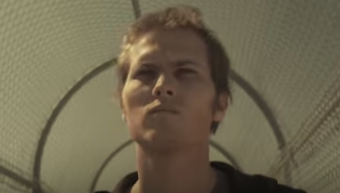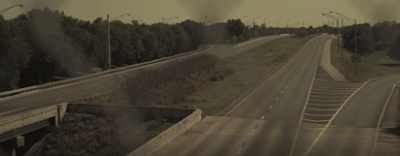Table 7
 Table 7 is a short film about a couple having a heated unknown argument whilst a mysterious chinese individual is listening in on the conversation.
Table 7 is a short film about a couple having a heated unknown argument whilst a mysterious chinese individual is listening in on the conversation. Genre:
Table 7 starts off with a thriller vibe, with blocking being used which is iconic of a thriller genre, it includes dark lighting and cuts back and fourth between the heated arguemnt and the unknown chinese man, the first time it cuts to the cinese man listening in on the convesation the soundtrack starts with an eery and mysterious vibe to it really setting an emotion in place, this makes us think hes some sort of spy listening to a some valuable information as he starts writing down what they are saying in a type of stranscript.
 At this current mommet in time we beleive this is a thriller and the chinese man works for the chinese government, it then begins to play out further as the music takes a slight crescendo and we start to beleive somethings big is going to happen when the chinese man gives someone the transcript with urgent manor but nothing is really revealed which cretates further enigma.
At this current mommet in time we beleive this is a thriller and the chinese man works for the chinese government, it then begins to play out further as the music takes a slight crescendo and we start to beleive somethings big is going to happen when the chinese man gives someone the transcript with urgent manor but nothing is really revealed which cretates further enigma.  It then concludes the man made fortune cookie quotes and actually had asnwers for the couples questions and in the end they make up; even though we never knew the real issue it makes the audience content and we realise the chinese man wasn't a spy or anything like that but just the maker of fortune cookie quotes that can relete to further situations it then ends with a little smile from the chinese man who has now gone from possible antagonist to protagonsit.
It then concludes the man made fortune cookie quotes and actually had asnwers for the couples questions and in the end they make up; even though we never knew the real issue it makes the audience content and we realise the chinese man wasn't a spy or anything like that but just the maker of fortune cookie quotes that can relete to further situations it then ends with a little smile from the chinese man who has now gone from possible antagonist to protagonsit. Narrative:
 The story is told through the chinese charcters eyes or in this case his ears as the story begins it includes blocking and the start of a heated convesation between a couple, at this point in the plot we aren't aware of anyhing but the fact this couple have some issues, the film then takes a turn for the weird as a mysterious chinese man is listening in on the convesation he starts writing a transcript translating what the couple are saying with a variety of close ups on the chiense man, his equipmet and the transcript whilst you hear the couple speaking from his headphones allowing you to straight away indicate the man is listening to the couple; this is furthermore evidence that we are seing through the chinese mans perspective although we know nohing of the chiense mans backstory we can hear friom his headphones which only he can hear in the film and he knows as much of the couple as us the audience seem to know.
The story is told through the chinese charcters eyes or in this case his ears as the story begins it includes blocking and the start of a heated convesation between a couple, at this point in the plot we aren't aware of anyhing but the fact this couple have some issues, the film then takes a turn for the weird as a mysterious chinese man is listening in on the convesation he starts writing a transcript translating what the couple are saying with a variety of close ups on the chiense man, his equipmet and the transcript whilst you hear the couple speaking from his headphones allowing you to straight away indicate the man is listening to the couple; this is furthermore evidence that we are seing through the chinese mans perspective although we know nohing of the chiense mans backstory we can hear friom his headphones which only he can hear in the film and he knows as much of the couple as us the audience seem to know.  The heated argument continues as the couples voices start to crescendo and both are getting more annoyed at each other, the chinese man then gives someone else the trascript urgently and it makes us think perhaps he knows something, but we dont know anything and if we are in the chinese mans perspective surely he knows nothing either which then develpos barthes theory of enigma keeping the audience on edge.
The heated argument continues as the couples voices start to crescendo and both are getting more annoyed at each other, the chinese man then gives someone else the trascript urgently and it makes us think perhaps he knows something, but we dont know anything and if we are in the chinese mans perspective surely he knows nothing either which then develpos barthes theory of enigma keeping the audience on edge.  It then cuts to a two-shot of the couple and then a close up of fortune cookies being put on the table they both end the convesation negatively saying they 'dont know what to say' too each other but once they open the fortune cookies a subtle answer to their question is in each cookie and it helps them reslove the arguemnt, then the start of a more jolly soundtrack begins to play as it cuts straight back to a close up of the chinese mans face who now is our clear protagonsit as he smiles for now we know he isn't a spy but a fortune cookie note maker and listens into convesations on the table to write the best fortune cookie.
It then cuts to a two-shot of the couple and then a close up of fortune cookies being put on the table they both end the convesation negatively saying they 'dont know what to say' too each other but once they open the fortune cookies a subtle answer to their question is in each cookie and it helps them reslove the arguemnt, then the start of a more jolly soundtrack begins to play as it cuts straight back to a close up of the chinese mans face who now is our clear protagonsit as he smiles for now we know he isn't a spy but a fortune cookie note maker and listens into convesations on the table to write the best fortune cookie.  This is a good example of Todorovs theory of equilibrium disequalibrium and new equilibrium as the couples relationship before the short story is equilibrium and the plots heated argument is the disequalibrium and the making up and forgiving at the end is the new equilibrium as they are on good terms now but they will never be exactly the same.
This is a good example of Todorovs theory of equilibrium disequalibrium and new equilibrium as the couples relationship before the short story is equilibrium and the plots heated argument is the disequalibrium and the making up and forgiving at the end is the new equilibrium as they are on good terms now but they will never be exactly the same. Audience:

 The audience for the short film can vary as it ends up being a 'feel good' film anyone who's in the mood for a happy film could pick this up and watch it but the main target audience has to be couples especially younger couples, both the actress and actor are young adults possibly late twenties early thirties so its obvious this will defiantly attract that audience but this film is about a young struggling relationship which is trying to deliver a message to its viewers that sometimes you need to jus say you are sorry and sometimes you just need to forgive and even if it gets rough and you aren't use or don't like arguing it happens and you shouldn't break up from it sometiems you just need to apologise and forgive. Thats why I thik this films target audience is young couples that might be in a situation and hopefully this feel good film can help resolve the situation there in or at least help them undertsand couples fight but there is always the right things to say to resolve the problemand return to a new equilibrium.
The audience for the short film can vary as it ends up being a 'feel good' film anyone who's in the mood for a happy film could pick this up and watch it but the main target audience has to be couples especially younger couples, both the actress and actor are young adults possibly late twenties early thirties so its obvious this will defiantly attract that audience but this film is about a young struggling relationship which is trying to deliver a message to its viewers that sometimes you need to jus say you are sorry and sometimes you just need to forgive and even if it gets rough and you aren't use or don't like arguing it happens and you shouldn't break up from it sometiems you just need to apologise and forgive. Thats why I thik this films target audience is young couples that might be in a situation and hopefully this feel good film can help resolve the situation there in or at least help them undertsand couples fight but there is always the right things to say to resolve the problemand return to a new equilibrium.











































